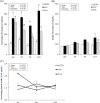d-allulose protects against diabetic nephropathy progression in Otsuka Long-Evans Tokushima Fatty rats with type 2 diabetes
- PMID: 35100325
- PMCID: PMC8803202
- DOI: 10.1371/journal.pone.0263300
d-allulose protects against diabetic nephropathy progression in Otsuka Long-Evans Tokushima Fatty rats with type 2 diabetes
Abstract
d-allulose is a rare sugar that has been reported to possess anti-hyperglycemic effects. In the present study, we hypothesized that d-allulose is effective in attenuating the progression of diabetic nephropathy in the Otsuka Long-Evans Tokushima Fatty (OLETF) rat model of type 2 diabetes mellitus. Drinking water with or without 3% d-allulose was administered to OLETF rats for 13 weeks. Long-Evans Tokushima Otsuka rats that received drinking water without d-allulose were used as non-diabetic control rats. d-allulose significantly attenuated the increase in blood glucose levels and progressive mesangial expansion in the glomerulus, which is regarded as a characteristic of diabetic nephropathy, in OLETF rats. d-allulose also attenuated the significant increases in renal IL-6 and tumor necrosis factor-α mRNA levels in OLETF rats, which is a proinflammatory parameter. Additionally, we showed that d-allulose suppresses mesangial matrix expansion, but its correlation with suppressing renal inflammation in OLETF rats should be investigated further. Collectively, our results support the hypothesis that d-allulose can prevent diabetic nephropathy in rats.
Conflict of interest statement
The authors have read the journal’s policy and have the following competing interests: MN, AK, and TI are paid employees of Matsutani Chemical Industry Co., Ltd. D-Allulose is a marketed product of Matsutani Chemical Industry Co., Ltd. These do not alter our adherence to PLOS ONE policies on sharing data and materials.
Figures



References
-
- Kikkawa R, Haneda M. Pathogenesis of Diabetic Nephropathy. Clin Exp Nephrol. 1997;1: 3–11. - PubMed
Publication types
MeSH terms
Substances
LinkOut - more resources
Full Text Sources
Medical

